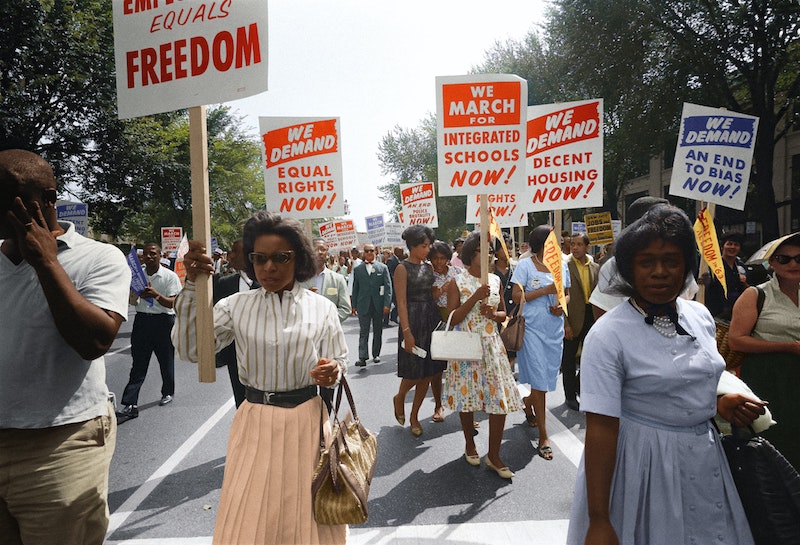What reparations for Black Americans could look like today

Central to the American Dream is the idea that every citizen has an equal opportunity to generate wealth and pursue happiness. The ideal professes that with gumption and hard work, each person can own a home, go to college, start their own business and nurture a nest egg for generations to come.
It’s a talking point critics of reparations return to time and again, said Stacey Deering, a Ph.D. candidate in political science and public programs consultant for The Charles H. Wright Museum of African American History.
“People say ‘Well, slavery was abolished in 1865,’” she said. “It’s not just about slavery. It’s what happened after—the generational trauma of Jim Crow segregation, perpetuated racism and injustices that we are still enduring that has created this crazy wealth disparity gap and equity issues.”
Lasting legacy

Black Americans suffered nearly two hundred and fifty years of slavery before their bodies were assigned a value of $3 billion and the cotton they produced $250
million in 1860, more than all the capital invested in infrastructure in the U.S. combined. Then came ninety years of Jim Crow segregation. Sixty more of “separate but equal.” Thirty-five of redlining and continuing to deny Black Americans the right to build intergenerational wealth.
The U.S. government has never atoned for all the equity lost, and today, the average white family possesses 10 times the wealth of the average Black family.
The U.S. could close that gap with reparations, but what would they look like today?
“When you think ‘reparations,’ you think 40 acres and a mule,” Deering said, referencing the very first attempt by the U.S. government to instill reparations after the abolishment of slavery—a thought quickly dropped after the Civil War when new presidential leadership moved into the White House.
That idea of a handout from the government holds sway in people’s minds when they think about reparations, Deering said, but it’s not a handout. The goal is to “create programs that address housing discrimination, economic development, student loan debt forgiveness, and access to better healthcare. All things that contribute to better quality of life for Black Americans.”
The point of reparations isn’t a one-and-done fix, but about lasting repair, restoration and restitution, she said.
Eyes on you, Detroit
The fight for reparations isn’t a new one for Black Americans, but it returned to the forefront of the collective American psyche in the aftermath of George Floyd’s murder and COVID.
Not to mention, Detroit has its own history of civil unrest and is the birthplace of H.R. 40, a bill first introduced by Rep. John Conyers, D-Mich., in 1989 that would create a commission to study slavery and discrimination in the U.S. and potential reparations proposals at the federal level. A bill that a growing number of Democratic lawmakers have given their support.
So earlier this year, The Wright Museum thought it was time to tackle the topic and tasked Deering with hosting a reparations study group and panel series to run throughout the summer.
40 participants attended the study group where they reviewed and discussed three books: Should America Pay: Slavery and the Raging Debate on Reparations by Raymond Winbush (2003), The Debt: What America Owes by Randall Robinson (2001), and From Here to Equality: Reparations for Black Americans in the 21st Century by William Darity and Kirsten Mullen (2020).
The study group was more intimate, Deering said, while the panel series was an opportunity to bring what was discussed in the group to the larger Detroit community.
Deering said participants showed up with varying knowledge and thoughts about reparations, but by the end, people told her they felt informed.
“To be able to debunk that negative connotation surrounding reparations by diving in and exploring the history and taking a look at what reparations can look like for African American citizens today helped a lot of people put it into perspective.”
And in the nick of time, as two proposals addressing reparation initiatives appeared on Nov. 2 ballots in Detroit.
Proposal R creates a task force to address the harms racism has inflicted on Black residents in the city and passed with 80% of the vote.
Deering said Proposal R is a must to start addressing the equity issues that have long plagued Black Detroiters, from the destruction of Black Bottom and Paradise Valley in the 1960s to the gentrification that is displacing residents today.
Notably, Proposal R doesn’t come with a revenue source. Proposal S, which would have changed Detroit’s city charter to allow more citizen control over funding, was intended to be that source, Deering said. “It would have rerouted funds from revenue generated by recreational marijuana.” But 54% of voters opted to reject Proposal S.
“I think it was more a timing issue, not having enough time to market and explain it so that citizens could understand and be more receptive to it.”
Still, she’s hopeful for the future and Proposal R is the start Black Detroiters deserve, Deering said.
“The cool thing is Detroit didn’t create the blueprints for this thing.”
A number of reparation task forces and programs have already been adopted by other cities across the nation. One city leading the charge is Evanston, Illinois, which grants up to $25,000 for down payments or home repairs from a city-created fund, she said.
“We can see what’s working elsewhere and build off that.”